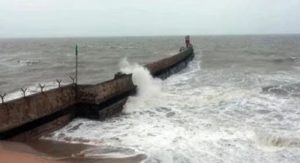
Low-latitude cyclones, those forming in the near-equatorial region, will increase in frequency and intensity in the coming years during a favourable phase of a Pacific climate phenomenon called the Pacific Decadal Oscillation (PDO), a new study has revealed.
This means more cyclones will be forming closer to India’s Peninsular coast for the North Indian Ocean region.
The paper published in Nature Communications on Monday titled “Pacific Decadal Oscillation Causes Fewer Near-Equatorial Cyclones in the North Indian Ocean” led by Arabian Center for Climate and Environmental Sciences, New York University Abu Dhabi and authors from India Meteorological Department (IMD) found that there is a 43% decline in the frequency of low-latitude cyclones (originating between 5°N and 11°N) during the post-monsoon season in the north Indian Ocean in recent decades (1981-2010) compared to earlier decades (1951-1980).
However, it is now set to increase again due to the combination of ocean warming and PDO being in a favourable position.
“This study was inspired from cyclone Ockhi (2017) which devastated Kerala and formed near the equator. It is very rare that tropical cyclones (TCs) form near the equator. This study says that Pacific Decadal Oscillation (PDO), which is a pacific climate phenomenon with 21-year cycle can influence low latitude cyclones by increasing the low-level vorticity which is a dynamical parameter for cyclone genesis. Now PDO has entered into a negative phase which should favour low latitude cyclones,” said M Rajeevan, former secretary, ministry of earth sciences and co-author of the paper.
“Theoretically this means the Peninsular coast is at greater risk of such cyclones but there are various other parameters that also influence cyclone development,” he added.
PDO is a long-term ocean fluctuation of the Pacific Ocean. The PDO waxes and wanes approximately every 20 to 30 years. It has a ‘cool’ and ‘warm’ phase according to National Aeronautics and Space Administration.
The last PDO phase shift was in 2014, when it turned strongly positive (warm). In the ‘warm’ or ‘positive’ phase, the west Pacific Ocean becomes cool and the wedge in the east warms.
Cyclones rarely form near the equator.
On average, there are fewer than two cyclones per year within 5° latitude of the equator, with the majority originating in the Western Pacific Ocean. A little away from the equator, however, cyclones can form more easily in the presence of a larger Coriolis force (deflection of circulating air due to earth’s rotation) and other favourable environmental conditions, the paper states.
These low-latitude cyclones (LLC) are much smaller in size than those in higher latitudes but intensify more rapidly.
The authors concluded that the decline in formation of low latitude cyclones (between 1981 and 2010) cannot be attributed to increasing sea surface temperatures and oceanic heat content which are in fact favourable factors for their formation and intensification.
The decline in LLC frequency in the recent epoch seems to be primarily caused by the reduced low-level vorticity and increasing vertical wind shear, the authors concluded.
“When this tug-of-war between the natural and anthropogenic forcing changes, and they begin to work synergistically, the risk of severe cyclones in the post-monsoon north Indian Ocean may be amplified. These results may guide planning and mitigating LLC-induced disaster in the Indian subcontinent,” the paper said.
A recent LLC was Ockhi which developed in November 2017 and travelled over 2,000 km.
It devastated parts of Sri Lanka and India with extensive damage to properties worth US$920M and killing 884 persons.
“Ockhi was peculiar as it created havoc over the south-western coast of India (Kerala, Karnataka coast and Sri Lanka). The occurrence of tropical cyclones over these regions is rare as it is the first very severe cyclone to form over the Lakshadweep Sea since 1925. Normally, tropical cyclones do not form near the equator (6.5°N in the case of Ockhi) due to the lack of adequate Coriolis force. This intrigued the team behind this study to look for occurrences of near-equatorial cyclones and their frequency,” the authors said




 Number of Indian Americans in elected offices not reflective of their population: Kamala Harris
Number of Indian Americans in elected offices not reflective of their population: Kamala Harris



























